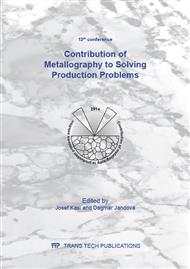p.3
p.9
p.17
p.23
p.38
p.47
p.59
p.66
p.72
Influence of Annealing Temperature and Time on the Mechanical Properties of Selected Steels for Heavy Forgings
Abstract:
Two types of steels used for production of heavy forgings were selected for the experimental evaluation of the effect of long time dwell at elevated temperatures and cooling during heat treatment on their mechanical properties in order avoid the possibility of grain boundary embrittlement. Samples from evaluated steels 26NiCrMoV14-5 and 22CrNiMoWV8-8 were austenitized for 2 hours at temperature of 1200°C and oil quenched. Subsequently the annealing at temperatures (200 - 700)°C for 1 hour and 100 hours was applied. Selected mechanical properties, especially hardness and impact energy, were monitored. It was found that for steels 26NiCrMoV14‑5 and 22CrMoNiWV8-8 exist the temperature intervals (300 - 400)°C and (500 ‑ 600)°C respectively with the possible potential for toughness decreasing.
Info:
Periodical:
Pages:
38-46
Citation:
Online since:
May 2015
Price:
Сopyright:
© 2015 Trans Tech Publications Ltd. All Rights Reserved
Share:
Citation:


